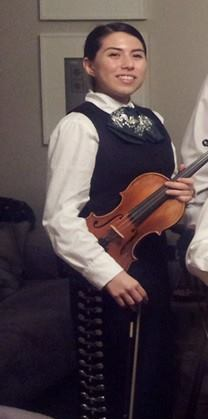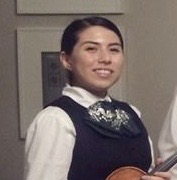(By ROXANNE CORONADO)
By the time she was a teenager, Joann Coronado knew countless mariachi groups and their songs due to her upbringing, so it wasn’t a surprise when she decided to join her school’s mariachi group as a violinist.
“The choices were band and mariachi,” Joann says about her high school options. “Since I was trained on a violin, I naturally gravitated towards the mariachi.”
Joann, now a 26-year-old government worker, has fond memories of playing with her mariachi group in Corpus Christi, Texas, around five years ago.

“It would be nice to see her return to playing mariachi someday,” says Jobita Coronado, Joann’s mother. “I enjoyed watching her play.”
Although the responsibilities of adult life ensure she can’t dedicate herself to her violin practice like before, Joann enjoys sharing the fond memories she has about those simpler days.
“Mariachi music is a traditional music genre of Mexico,” Joann says. “The groups normally consist of a couple of violins, some guitars, an instrument called the vihuela, a guitarrón and sometimes trumpets as well.”
In larger mariachi groups, they also may have harps, accordions or flutes.
“For the music itself, there are a lot of different types of feelings. It can be played somberly; it can be played for dancing or for singing along. I feel like the bulk of it would probably be meant to be sung along with while you’re having drinks with a large group.”
Joann describes her old mariachi group as one that performed for restaurants and different special events that individuals hired for a certain number of hours. All group members had to sing, since some songs are purely instrumental.
“A person can request a song they like. So, it generally depends on the mood of that person or what they feel like hearing,” Joann says.
Due to this system, it was not uncommon for Joann’s group to play a somber or sad song before a fun, dancing song for the same group of people.
Usually, mariachi groups dress in a certain manner. Their trajes, or suits in English, consist of a white button up shirt, a vest, decorated pants, boots, and a decorated jacket over the vest for the men.
Women wear similar clothing, but they wear decorated skirts instead of pants. Women also usually wear their hair in a ponytail and may choose to wear a hair decoration that matches the suit’s color.
Joann says the suits are heavy. “When you walk, you can hear it jingle.”
Show mariachi groups, ones that perform across the country, have hats, but they are usually put on the floor as decoration instead of being worn.
Joann describes the experience as nerve-wracking.
“I didn’t want to sing or play because I thought everyone was watching me,” Joann says. “Anytime I didn’t know a certain song I would just not play.”
Now Joann has a different view on playing in front of others.
“Over time, it just became second nature,” Joann says. “You just get there and start playing, and you don’t even think about it anymore.”




